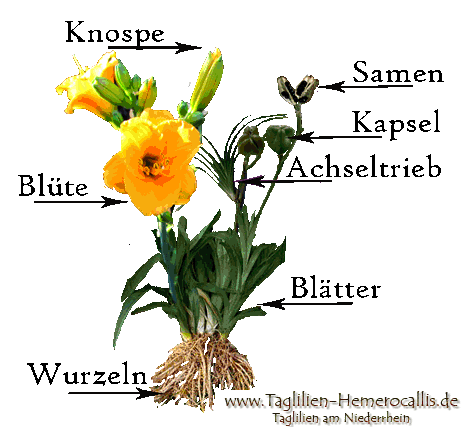Name origin:The genus name Hemerocallis "day beauty" comes from the Greek words "hemera" = day, "kallos" = beauty and is related to the short duration of each flower. Each flower blooms only for a day. One mature flower stalk produces dozens of flower buds, therefore this fact is not so serious. An older plant e.g. produces up to 500 flowers. This extends the flowering period up to four weeks. Through a combination of early and late flowering varieties it makes a flowering period of several months possible.Structure of the Daylily:
|
||||||||||||||||||||||||
Daylily breeding : The first breedings of modern hybrids had begun in the 1930s. The famous German writer and perennial breeder Karl Foerster (born 9 March 27, 1874 in Berlin, † November 1970 in Bornim) wrote in 1969: "In the kingdom of Hemerocallis-opened to us a whole new continent of flowers from a variety joy beyond all of our hunches. "
|
| till 1900 : | 4 varieties |
| till 1910 : | 46 varieties |
| till 1920 : | 66 varieties |
| till 1930 : | 128 varieties |
| till 1940 : | 577 varieties |
| till 1950 : | 3.284 varieties |
| till 1960 : | 8.624 varieties |
| till 1970 : | 15.527 varieties |
| till 1980 : | 22.827 varieties |
| till 1990 : | 33.114 varieties |
till 2000 : |
48.354 varieties |
| Current count at 28.09.2011 | 70.067 varieties |
By now, there are more than 70,000 in the AHS (American Hemerocallis Society) registered and provided with named varieties. The registration of a variety costs about 15.00 €. To search for specific varieties or their properties (e.g., diploid or tetraploid), you can use the database of AHS.
Only the AHS world registers all new selections. Its European counterpart is the Hemerocallis Europe http://www.hemerocallis-europa.eu. It is a non-profit organization dedicated to promoting and disseminating the Daylily.
Even Germany employs its own
group "Hemerocallis" in the Gesellschaft der Staudenfreunde (GdS) with these beautiful plants. There are currently three screening Gardens (Cottbus, Schortens and Weinheim), divided into three climate zones. Here are planted several daylily varieties by the European breeders, which were rated according to a special assessment.





